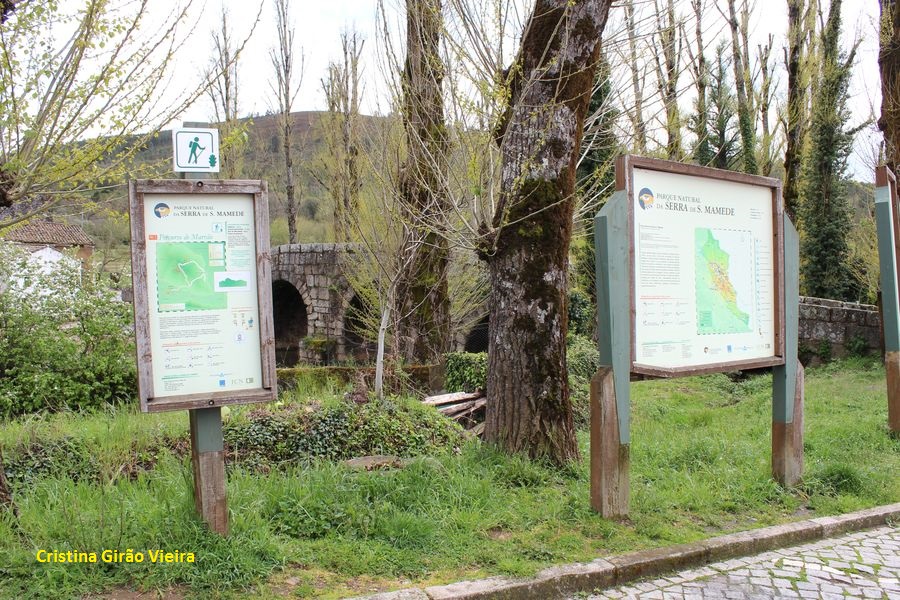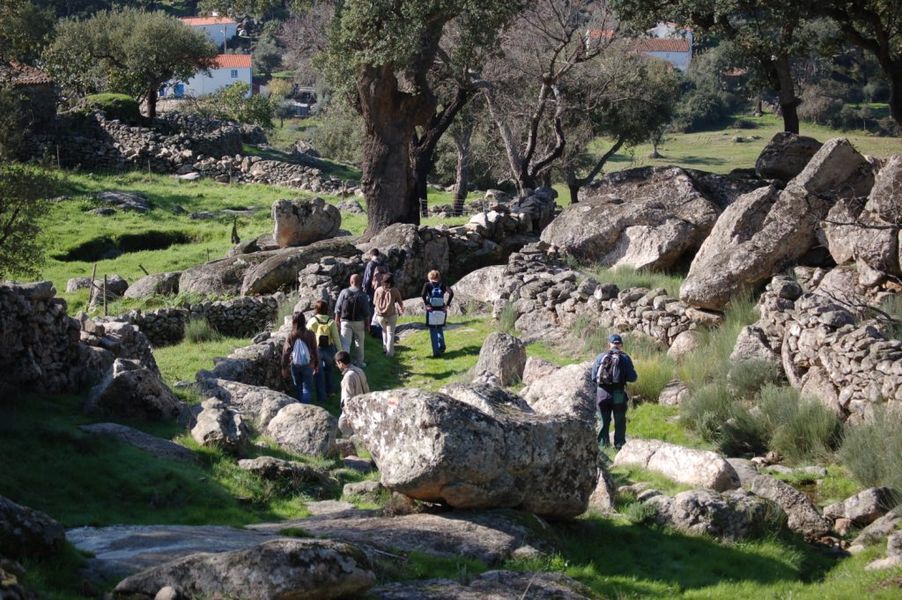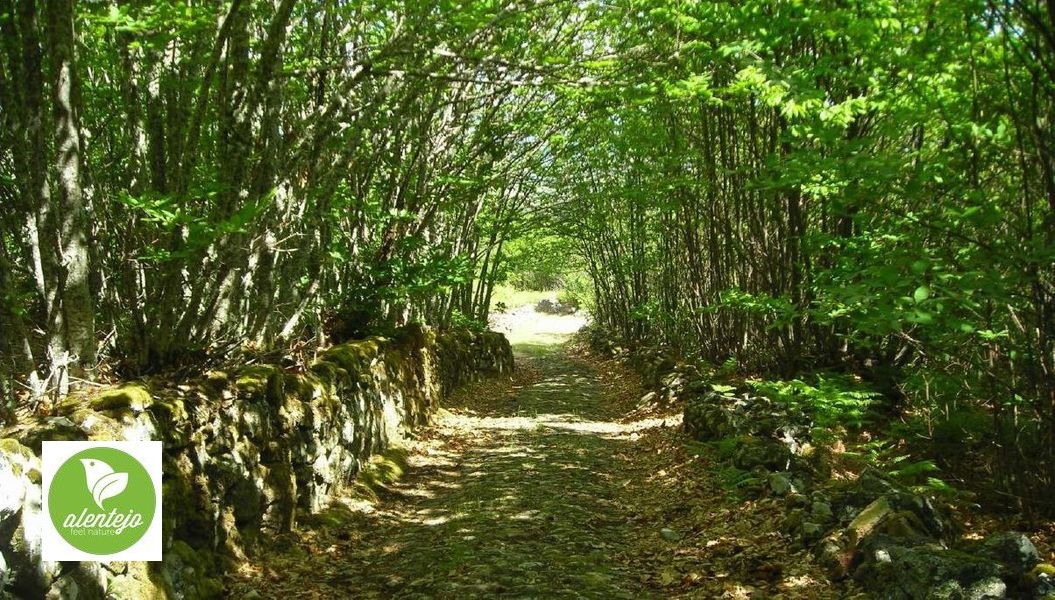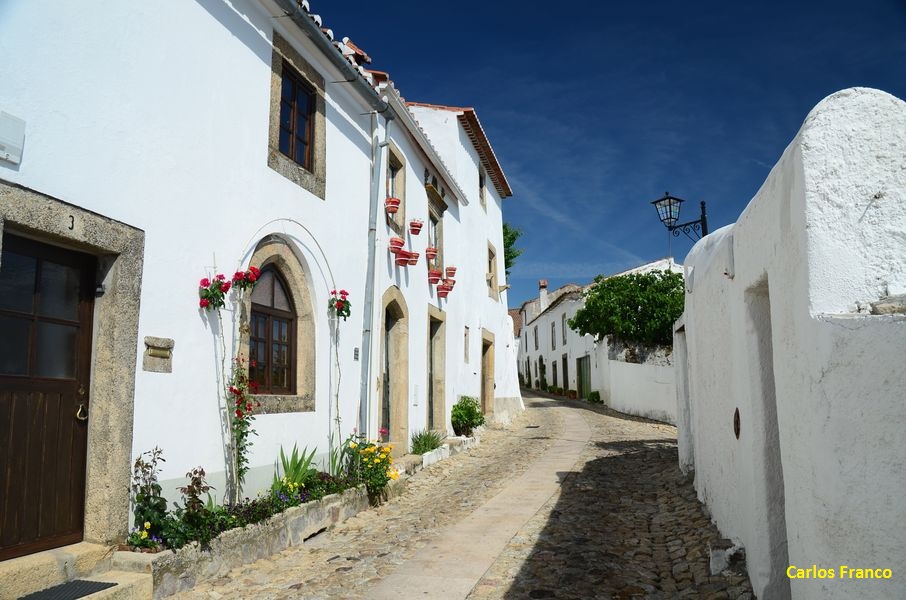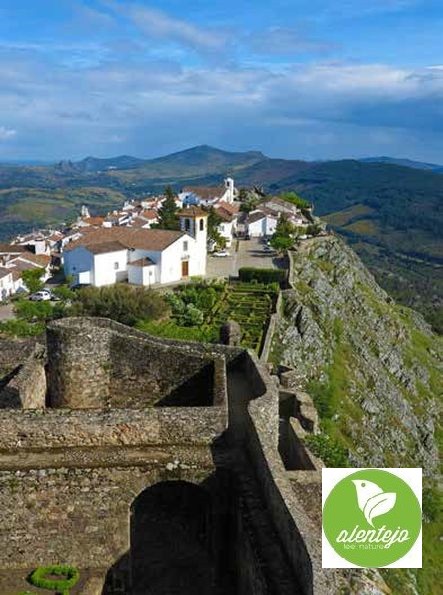PR1 MRV Percurso de Marvão
Share Image
The walking path begins and ends in Largo das Almas (Souls square), at Portagem (Toll) village, where the magnificent poplars line the banks of Sever river. Further on are small farmsteads with olive, cherry and chestnut trees. At the end of the tarred road we come to a medieval cobbled lane, possibly of Roman origin. The pathway goes through a wooded area embracing cork oak, Pyrenean oak and chestnut trees. As we approach Sra. da Estrela (Our Lady of the star), cork trees become more plentiful. The view is magnificent: to SE the dramatic peaks of quartzite; and to S the Selada hills and Pico (peak) of São Mamede. After a short stretch of tarred road we come to another medieval road, flanked by granite walls overgrown with ivy and lichen. At the end of the cobbled lane the path turns towards Abegoa, a cluster of small houses with large chimneys (a way to keep the houses fresh in summertime). From here, the convent and church of Sra. da Estrela is visible against the granite backdrop. From Abegoa, the path continues through a granitic landscape where oaks are dominant and with cork trees in drier areas. At Fonte Souto, there is a 19th century chapel worth mentioning, now derelict and deconsecrated, and two medieval tombs excavated in the rock. The pathway then meets up with the first stage of the path, passing through an important cork oak forest. WILDLIFE: among the bird species, the following are worth mentioning due to their rarity: the ring ouzel, the blue rock thrush and the black wheatear. Also some birds of prey, namely the buzzard, the kestrel, the little owl and the tawny owl. Amongst the mammals are the wild boar, the civet cat, and otters in the Sever River. In the reptile family, note-worthy species include the snub-nosed viper, the Iberian frog and the Iberian emerald lizard, which are endemic to the Iberian Peninsula. HERIAGE: Medieval stone-paved roadway; castle, fortifications, pillory and historic borough of Marvão; Manueline cross; Church and Convent of N. Sra. da Estrela; Portagem Bridge and Toll Tower. HANDICRAFTt: traditional embroidery with chestnut peel; basketry in chestnut tree wood. GASTRONOMY: soup of sarapatel; lamb stew; cachafrito of little goat; alhada of dogfish; thin bread with chestnuts. Sweets (Chestnut cake, apple boleima and aramenha pie). Chestnuts (Protected Designation of Origin – PDO).

-
The walking path begins and ends in Largo das Almas (Souls square), at Portagem (Toll) village, where the magnificent poplars line the banks of Sever river. Further on are small farmsteads with olive, cherry and chestnut trees. At the end of the tarred road we come to a medieval cobbled lane, possibly of Roman origin. The pathway goes through a wooded area embracing cork oak, Pyrenean oak and chestnut trees. As we approach Sra. da Estrela (Our Lady of the star), cork trees become more plentiful. The view is magnificent: to SE the dramatic peaks of quartzite; and to S the Selada hills and Pico (peak) of São Mamede. After a short stretch of tarred road we come to another medieval road, flanked by granite walls overgrown with ivy and lichen. At the end of the cobbled lane the path turns towards Abegoa, a cluster of small houses with large chimneys (a way to keep the houses fresh in summertime). From here, the convent and church of Sra. da Estrela is visible against the granite backdrop. From Abegoa, the path continues through a granitic landscape where oaks are dominant and with cork trees in drier areas. At Fonte Souto, there is a 19th century chapel worth mentioning, now derelict and deconsecrated, and two medieval tombs excavated in the rock. The pathway then meets up with the first stage of the path, passing through an important cork oak forest. WILDLIFE: among the bird species, the following are worth mentioning due to their rarity: the ring ouzel, the blue rock thrush and the black wheatear. Also some birds of prey, namely the buzzard, the kestrel, the little owl and the tawny owl. Amongst the mammals are the wild boar, the civet cat, and otters in the Sever River. In the reptile family, note-worthy species include the snub-nosed viper, the Iberian frog and the Iberian emerald lizard, which are endemic to the Iberian Peninsula. HERIAGE: Medieval stone-paved roadway; castle, fortifications, pillory and historic borough of Marvão; Manueline cross; Church and Convent of N. Sra. da Estrela; Portagem Bridge and Toll Tower. HANDICRAFTt: traditional embroidery with chestnut peel; basketry in chestnut tree wood. GASTRONOMY: soup of sarapatel; lamb stew; cachafrito of little goat; alhada of dogfish; thin bread with chestnuts. Sweets (Chestnut cake, apple boleima and aramenha pie). Chestnuts (Protected Designation of Origin – PDO).
-
Alentejo
-
Marvão
-
Serra de S. Mamede Nature Park
-
Cultural and Environmental Interpretation Centre of Cova Mill
Base Characterization
-
PTCON0007 São Mamede
-
CIMAA - Comunidade Intermunicipal do Alto Alentejo
Route Characterization
-
Access to Portagem coming from:
- Marvão (about 6 km) - N359-6 and N359;
- Spain by Fronteira dos Galegos (about 6 km) - IC 13;
- Castelo de vide ((about 8 km) - EN 246-1; or
- Portalegre (about 12 km) - N 359.
-
Yes
-
Parking by the metal bridge of Sever river.
-
Parking by the metal bridge of Sever river.
-
8.2 km
-
All year, but you should avoid Summer.
-
4 h
-
283 meters
-
Medium
-
Ring road
-
Todos os grupos
Supports in place
-
Yes.
-
Marvão - tourist office, accommodation, restaurants, small supermarket, pharmacy and ATM. Portagem - accommodation, restaurants, supermarket and ATM.
Topographic Profile
The route can be done all year round, with some precautions in summer due to high temperatures and in Winter because of the slippery floor.
Access to Portagem coming from:
- Marvão (about 6 km) - N359-6 and N359;
- Spain by Fronteira dos Galegos (about 6 km) - IC 13;
- Castelo de vide ((about 8 km) - EN 246-1; or
- Portalegre (about 12 km) - N 359.







